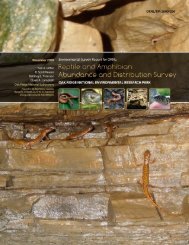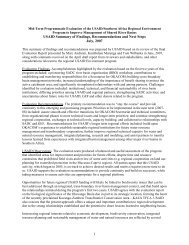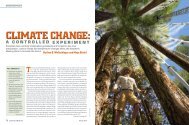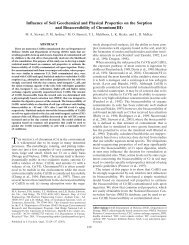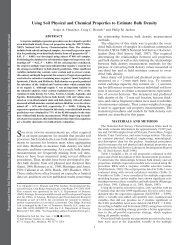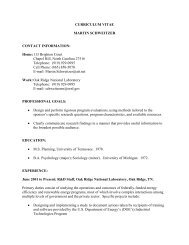oak ridge reservation physical characteristics and natural resources
oak ridge reservation physical characteristics and natural resources
oak ridge reservation physical characteristics and natural resources
You also want an ePaper? Increase the reach of your titles
YUMPU automatically turns print PDFs into web optimized ePapers that Google loves.
proximity to terrain. The depth of the surface mixing layer is usually correlated to atmospheric<br />
stability, which is the tendency of the atmosphere to mix vertically. The local <strong>ridge</strong>-<strong>and</strong>-valley terrain<br />
primarily affects stability through the reduction of surface winds, which tends to allow for the<br />
development of very stable surface layers (i.e., strong temperature inversions) at night, particularly<br />
under clear skies <strong>and</strong> light background winds.<br />
2.6 STABILITY<br />
Stability describes the tendency of the atmosphere to mix or overturn. Consequently, dispersion<br />
parameters are influenced by the stability <strong>characteristics</strong> of the atmosphere. Stability classes range<br />
from “A” (very unstable) to “G” (very stable). The “D” stability class represents a neutral state. The<br />
local <strong>ridge</strong>-<strong>and</strong>-valley terrain plays a role in the development of stable surface air under certain<br />
conditions <strong>and</strong> influences the dynamics of airflow.<br />
The suppression of vertical motions during stable conditions increases the frequency with which<br />
air motion is impacted by the local terrain. Conversely, stable conditions isolate wind flows within the<br />
<strong>ridge</strong>-<strong>and</strong>- valley terrain from the effects of more distant terrain features <strong>and</strong> from winds aloft. These<br />
effects are particularly true with respect to mountain waves. Deep stable layers of air tend to reduce<br />
the vertical space available for oscillating vertical air motions caused by local mountain ranges<br />
(Smith et al. 2002). This effect on mountain-wave formation could be important with regard the<br />
impact that the nearby Cumberl<strong>and</strong> Mountains might have on local airflow.<br />
A second factor that could decouple large-scale wind-flow effects from local ones (<strong>and</strong> thereby<br />
produce stable surface layers) occurs with overcast-sky conditions. Clouds overlying the Great Valley<br />
can warm as a result of direct insulation on the cloud tops. Warming can also occur within the clouds<br />
as latent energy is released because of the condensation of moisture. Surface air underlying the clouds<br />
can remain relatively cool (because it is cut off from direct exposure to the sun). Consequently, the<br />
vertical temperature gradient associated with the air mass can become more stable (Lewellen <strong>and</strong><br />
Lewellen 2002). Long wave cooling of a fog deck has also been observed to help modify stability in<br />
the surface layer (Whiteman et al. 2001). Stable boundary layers typically form as a result of<br />
radiational cooling processes near the ground (Van de Weil et al. 2002); however, they are also<br />
influenced by the mechanical energy supplied by horizontal wind motion (which is in turn influenced<br />
by the large-scale weather-related pressure gradient). The <strong>ridge</strong>-<strong>and</strong>-valley terrain can have a<br />
significant ability to block such winds <strong>and</strong> their associated mechanical energy (Carlson <strong>and</strong><br />
Stull 1986). Consequently, enhanced radiational cooling at the surface results because less wind<br />
energy is available to remove chilled air.<br />
Stable boundary layers also exhibit intermittent turbulence that has been associated with a<br />
number of the above factors. The process results from give-<strong>and</strong>-take between the effects of friction<br />
<strong>and</strong> radiational cooling. As a stable surface layer intensifies through a radiation cooling process, it<br />
tends to decouple from air aloft, thereby reducing the effects of surface friction. The upper air layer<br />
responds with an acceleration in wind speed. Increased wind speed aloft results in an increase in<br />
mechanical turbulence <strong>and</strong> wind shear at the boundary with the stable surface layer. Eventually, the<br />
turbulence works into the surface layer <strong>and</strong> weakens it. As the inversion weakens, friction again<br />
increases, reducing winds aloft. The reduced wind speeds aloft allow enhanced radiation cooling at<br />
the surface, which re-intensifies the inversion <strong>and</strong> allows the process to start again. Van de Weil et al.<br />
(2002) have shown that cyclical temperature oscillations up to 39°F can result from these processes.<br />
Because these intermittent processes are primarily driven by large-scale horizontal wind flow <strong>and</strong><br />
radiational cooling of the surface, the <strong>ridge</strong>-<strong>and</strong>-valley terrain significantly affects these oscillations.<br />
7




